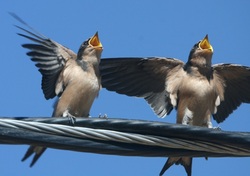
Given any morning in the suburbs, it is easy to hear birds causing quite a ruckus outside one’s window. Each species has distinct calls that are used for a variety of reasons; as a means of identification, as a mating call, as a warning or sign of prominence, or merely as a means of communication to other birds in the species. Birds are capable of producing a wide variety of sounds that can be used by humans to identify the species, and their behavior.
Some bird calls are programmed into their genetics; these include flycatchers. These birds are able to produce these sounds from the minute they are born, with no teaching or learning necessary. The majority of birds, on the other hand, must learn their calls from their parents or from others in their species. This usually takes place during a sensitive learning period, during which the young bird imitates the calls, and eventually perfects them through practice. By the end of the sensitive period, the young birds are capable of reproducing the newly learned calls exactly as they heard them. Each species of bird is a little different with how it learns the bird calls and each repertoire is different. While mockingbirds can imitate hundreds of different bird calls from numerous different species, some others only learn a few calls in their lifetime.

Birds produce sound through the use of the syrinx- their version of the voice box. The syrinx is located atop a bird’s two lungs and connected to both bronchi. Thus it is capable of producing a wide variety of pitches and sounds. When air passes through the syrinx, the membranes within it vibrate, which is what produces the sound. Birds are able to produce long lasting songs, seemingly without breathing because their breathing patterns are synchronized with each note, and the bird actually takes mini-breaths in between notes. Thus the song sounds continuous but birds never get out of breath. Birds use their vocal muscles to produce an incredibly wide variety of pitches through the control of the membranes and syrinx.
Birds often produce chorus effects through many of them singing at once. Perfect duets between birds are often part of mating rituals, and many times, the choirs of birds perform their songs at early hours in the morning. In addition, sometimes, when it sounds like there are several birds are singing it is really only one or two; birds are capable of producing very complex sounds through the proper use of their vocal equipment.
Bird calls and songs have become an important part of identifying birds, and are very common to hear on any day. Although their primary purpose is certainly not to serve human pleasure, they definitely have a degree of beauty and awe.